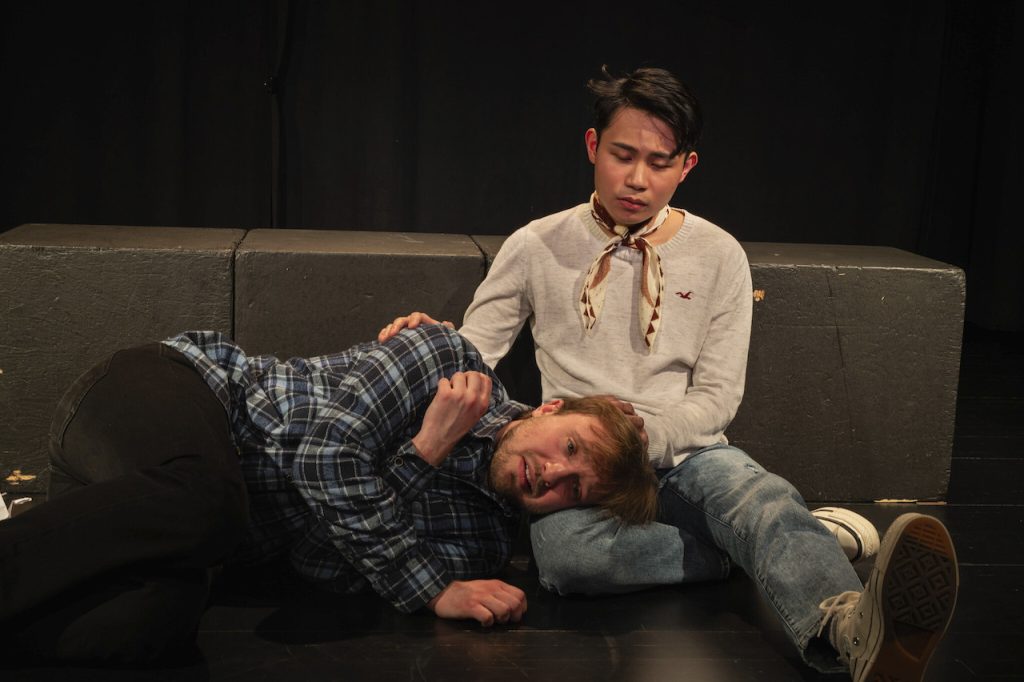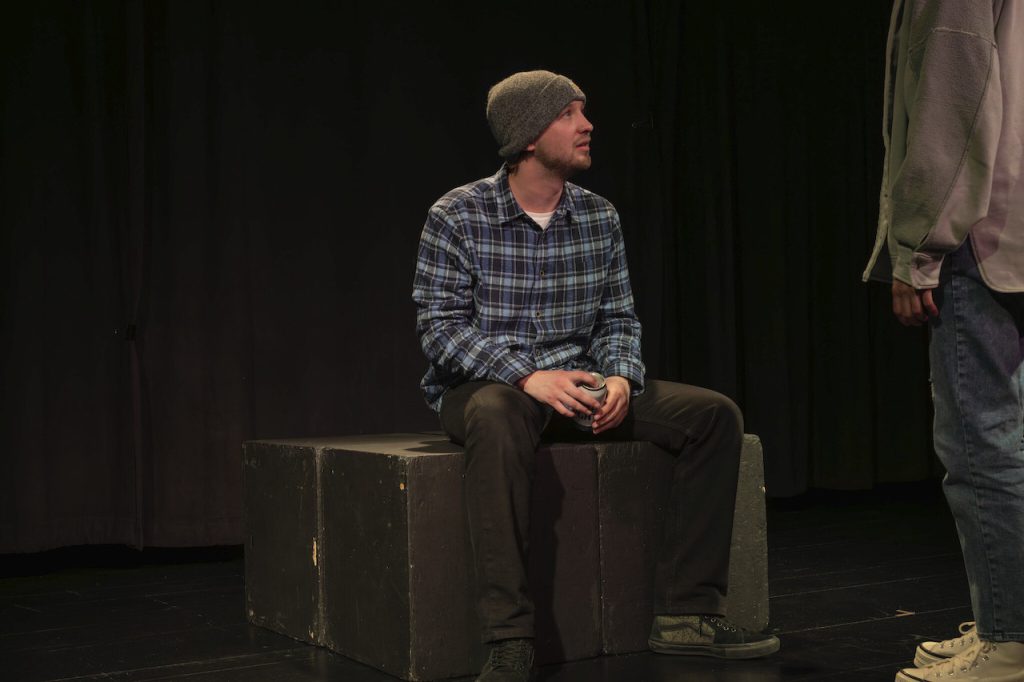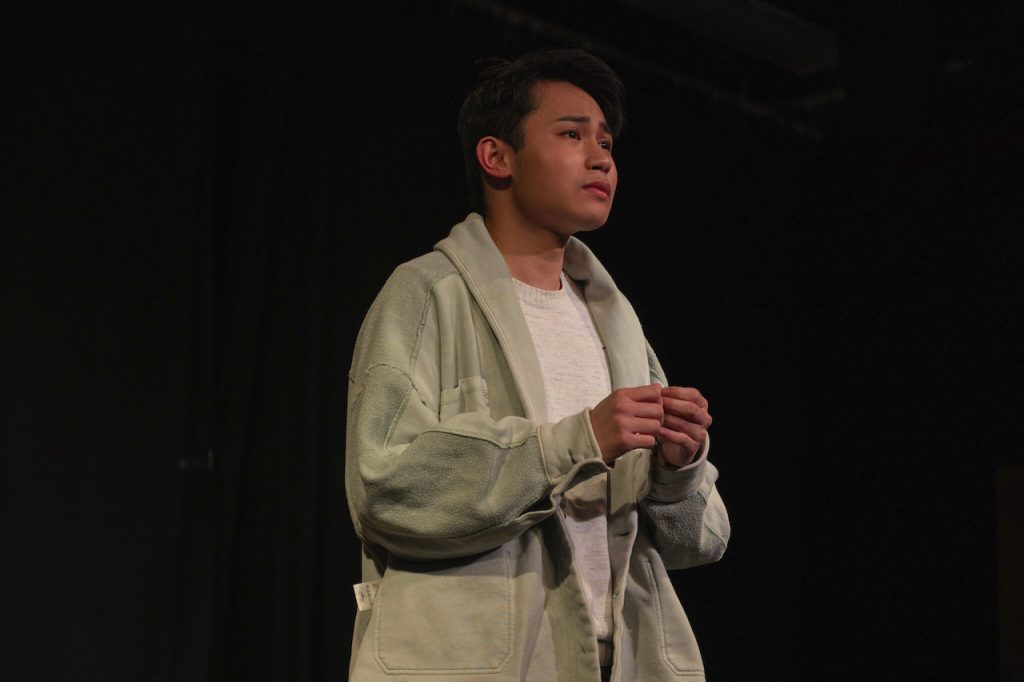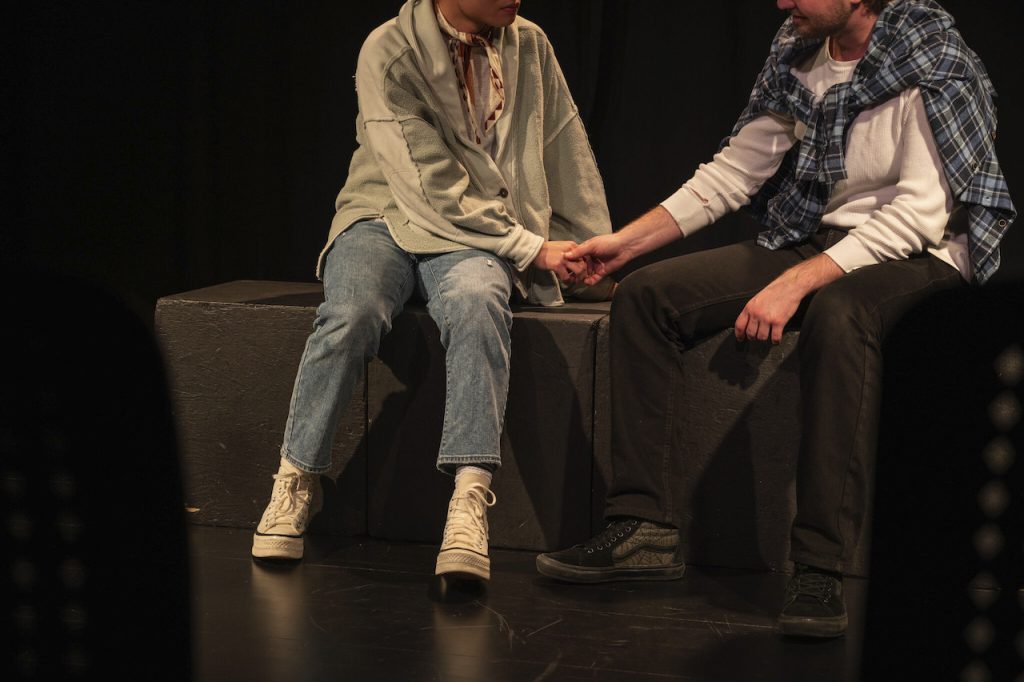BY GRAY BIRCHBY ’28
This semester’s second studio lab, The Year It Stops, written by Reyn Ricafort ‘25 and directed by Stephanie Kemple ‘25, premiered on March 20th and 21st in the Janet Kinghorn Bernhard Theater’s Studio A.
As the audience takes our seats, Luis (Reyn Ricafort ‘25) is folding five paper cranes. This also serves as the play’s opening, immediately immersing showgoers in Ricafort and Kemple’s vision of a world that they are likely familiar with – 2020, an era rich with both connection and disconnection, something closely explored in Ricafort’s play.
The play formally opens on a conversation between Luis (Reyn Ricafort ’25) and Joshua (Jimmy Katzmann ‘25). The two met via dating app, which Joshua insists is a glitch as his app is set to find women only. (Luis, of course, presses him on this – just because his app glitches does not mean that Joshua had to swipe right). This moment sets the stage for the anxieties that haunt the play–as well as the humor expertly woven in. We are instantly transported to the world of suburban eastern Massachusetts. The play continues to make references to Massachusetts culture, namedropping towns like Natick and Wellesley.

The first meeting that we see between the two showcases an instant physical connection; Luis and Joshua start the play physically exploring one another while also getting to one another – first kisses are interspersed with discussions of futures at Boston University. Soon, the though, the two separate, the scene slightly changes.
Transitioning between scenes lights fade, staticky radio plays, and the actors quickly move bandanas and coats to give the appearance of new outfits. The costume changes throughout the play were amazing, showing the transition of time effortlessly; character’s costumes shift to align with the seasons, effortlessly guiding the audience through the relationship between Luis and Joshua.
Throughout The Year It Stops, this car provides an initial escape from the realities of the outside world. The intimacy between Luis and Joshua was awkward in a very relatable way; the audience laughed as they watched the two try to figure out how to kiss without bumping into one another.
The Year it Stops commits itself to exploring power dynamics shaped by age, education and class; Luis is younger, but is more educated and from a more financially privileged. On the other hand, Joshua is much older than Luis but he is also much more economically disadvantaged.

The play’s setting of the COVID pandemic is one that showgoers are likely familiar with, and Ricafort’s writing was uniquely situated within that time, referencing memes of the era. The play’s soundtrack – featuring modern artists such as Zach Bryan – only strengthened this connection, while also serving as a gateway into further developing the character’s interests, showcasing Ricafort’s dedication to writing well-rounded characters that feel like real people.
The sound, designed by Elena Chawla ‘26, was masterfully done. Radio sounds play over the darkened stage in scene transitions, growing less static-like with each scene change. This growing clarity seems to suggest the horrors experienced in 2020; as these horrors grow closer to the personal lives of the characters, the music gains clarity, showcasing a return to total reality.
Tension becomes apparent towards the play’s midpoint. Joshua lies on his back, breathing in and out, as Luis chatters away about the politics of high school. Something seems off about Joshua, though, and Luis is fixated on asking him what exactly is wrong. This choice of Luis’ causes Joshua to lash out. This lashing out has been bubbling up for a while; not only because of Luis’ incessant pestering, but also because of Luis’ ignorance of class differences.
Also towards the play’s middle, Joshua’s political leanings are revealed when he makes an off-kilter remark about wishing violence on Black Lives Matter protestors, which Luis finds troubling. In placing Joshua on the more far right side of the political spectrum, Ricafort breaks down a multitude of cultural stereotypes; the idea that all queer men are liberal, as well as the commonly held belief that Massachusetts is a liberal haven.

Though only a few blocks were used to set the stage, everything was interacted with both as an onstage moment and an effective transition. For instance, as we start to watch Joshua descend into alcoholism The use of props felt natural as Joshua kicked bottles back under the curtain, both clearing the stage and showing his emotions in that scene.
Joshua’s father dies from COVID-19 complications. As a result, the family’s financial suffering keeps compounding. An anonymous donation page is set up, but Joshua remains adamant he does not want to rely on handouts. The fear that both characters feel is what truly drives the play toward its conclusion.
Despite this fear and tension in a play about what queerness means, there is still levity. For instance, in one memorable moment, Joshua tells Luis he knows Luis was the anonymous fundraiser for his family, citing the fact that set up the username of the creator had the word “origami” in it, and the fact that the donor was out of Luis’ hometown of Wellesely, Massachusetts.

The play begins to wrap up as Luis tells Joshua he wants to go into Boston but hesitates to go alone. We see how much he depends on Joshua. However, the scene shifts as Luis begins to pressure Joshua beyond his comfort points, and the scene turns into a fight. Joshua is uncomfortable being out and worried someone they know will see them. In response, in a moment that shatters the earlier joy brought by Luis’ fundraising, Luis argues that Josh “owes” him for saving his family, bringing out a crueler side of Luis.
The scene shifts, and the news plays a description of a Filipino-American college student who is pushed onto train tracks, presumably an anti-Asian hate crime. The radio loops the news of the tragedy as Joshua cries.
The play ends with a dreamlike scene where Joshua sees Luis at a train station. Joshua begs Luis to get in his car with him, begging and saying that he will do anything to fix tis. Luis tells Joshua that he needs to move on, and steps into a patch of light, his white parka gleaming. The white patch of light is both a literal representation of Luis stepping onto the train and a metaphor for his demise.
The Year it Stops is a powerful meditation on what it means to come together and fall apart during adversity. Ricafort’s thrillingly engaging writing, alongside Kemper’s beautiful direction, is carried by the humor woven in this engaging watch.

Photos by Logan Waugh
***
Gray Birchby ’28 is a staff writer for the Skidmore Theater Living Newsletter
